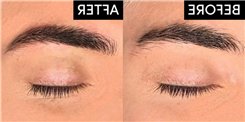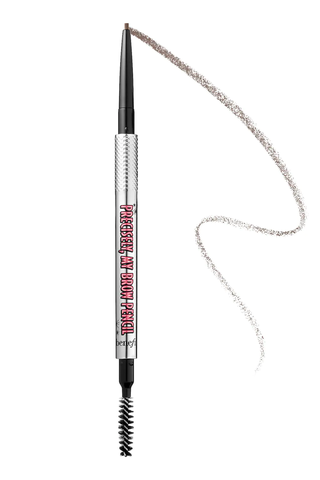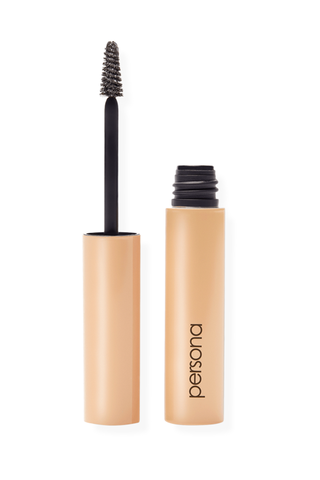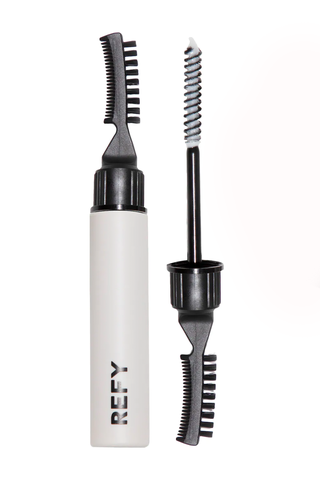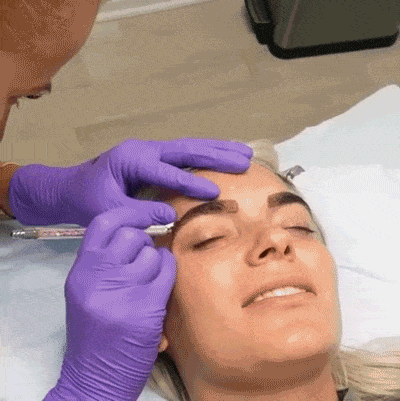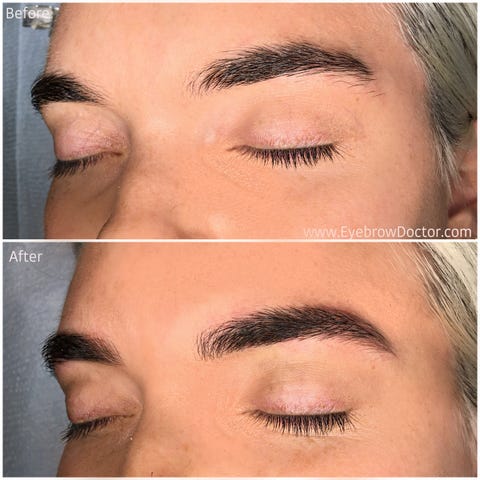If I had a dollar for every minute spent meticulously filling in my eyebrows in front of the mirror, I would be a v rich—yet still v annoyed—lady. My disdain for having to use a combination of brow pencils, brow gels, brow pomades, and even soap (hey, soap brows) every single day is what led me to finally try microblading, a semi-permanent form of brow tattooing. I know, I know; thinking of microblading as a “brow tattoo” sounds a lil scary, but it doesn’t last forever and has a surprisingly easy (and almost painless) healing process when done properly.
So if you’re even slightly intrigued about microblading, you’re in the right place. Because I chatted with cosmetic tattoo specialist Piret Aava, brow artist Alixandria Capparelli, and dermatologist Tracy Evans, MD, to find out what exactly is microblading, how painful it is, how much it costs, and how quickly it fades. Keep reading, then check out all the before-and-after pics from when one Cosmo editor tried it themselves.
Microblading 101
What is microblading?
Microblading is a semi-permanent form of cosmetic tattooing. But unlike traditional tattoos, which use a tattoo gun, microblading uses a blade-shaped tool with a row of tiny, barely visible needles to create hair-like strokes along your brows while depositing pigment into your skin. The result? Realistic-looking brow hairs that don’t wash off for a year or more.
Not ready for microblading? Try these 4 brow products
https://www.instagram.com/p/BxiFnx4h7GM/?utm_source=ig_embed&utm_campaign=loading
A post shared by 🚨Eyebrow Doctor®️Piret Aava (@eyebrowdoctor)
Is microblading a tattoo?
Microblading is a type of tattoo, but it’s not permanent like a true tattoo. Not only do the two use different “inks”—traditional tattoos use concentrated tattoo ink, while cosmetic tattoos use smaller pigment particles—but they’re also applied differently. With microblading, the pigment is applied superficially to your skin (so your body eventually metabolizes it until it fades away), rather than placed into your skin’s deeper layers (where it becomes permanent).
Because of the pigment used and the way it’s applied to the skin, microblading produces a semi-permanent “tattoo” that looks soft and subtle, instead of opaque and bright as with traditional tattoos. Over time, the pigment on your brows will also lighten a shade or two from its original color, whereas a tattoo on your body can have a blue-green tint on the edges when it starts to fade.
Who is a good candidate for microblading?
A good candidate for microblading isn’t necessarily based on how little (or how much) brow hair you naturally have—it’s more based on your skin type. Is your skin super reactive and sensitive? Do you have keratosis pilaris on your forehead? Do you currently or consistently deal with breakouts or cystic acne around your brows?
Then you may not be a great candidate at the moment, since microblading will initially cause some inflammation that can exacerbate skin conditions and affect your tattoo’s healing process. Similarly, oil can make microblading fade faster, so you’ll get less time with your microbladed brows if your skin is very oily.
“I try to warn patients against microblading if they have sensitive skin, or if they’re prone to allergies with other types of topicals,” says Dr. Evans, noting that some people can get allergic contact dermatitis after microblading, resulting in an itchy, scaly, cracked rash. If a reaction does occur after your appointment, see your dermatologist asap who can prescribe a steroid to bring down symptoms and prevent damage to your tattoo, then call your cosmetic tattoo artist and inform them of your reaction.
FYI: Most brow artists will not microbladed pregnant or breastfeeding clients to avoid risks of infection (sry!). Clear it with your doctor first, and wait six weeks after giving birth and stopped breastfeeding before booking your appointment. You also need to wait until after finishing Accutane to get microblading because it makes your body prone to excessive sensitivity and bleeding.
https://www.instagram.com/p/BK4aPFIj4nc/?utm_source=ig_embed&utm_campaign=loading
A post shared by 🚨Eyebrow Doctor®️Piret Aava (@eyebrowdoctor)
Is microblading only good for thin brows?
Microblading can be great for those with thin, sparse brows to get some definition and fullness, but Capparelli warns it might not look as natural as someone who does have hair behind the draw-on strokes. But if you’re worried about your microbladed brows looking too drawn-on, your brow artist can add shading behind the hair-like strokes so the empty spaces between the strokes isn’t so noticeable.
Those who already have some eyebrow hair and just want a lil fill-in or enhancement to their natural brows can get a very natural look with microblading, says Capparelli. However, microblading might not be good for someone with lots of natural eyebrow hair, because all it will do is make your brows look fuller, not brushed up or groomed (only a brow gel or brow lamination can do that).
What is the downside of microblading?
There are potential downsides to microblading, as there are with any cosmetic procedure. Capparelli says that the biggest concern her clients have is how brow trends may shift in the future. Example: the thick, bold, Instagram brows of 2016 that were literally everywhere? Basically nonexistent a year later, which may not be ideal for someone who got theirs tattooed on and now wants a change.
And, unfortunately, microblading can take anywhere from 1-3 years to fade on its own, so if you’re someone who tends to adapt your makeup to current trends, you might want to reconsider microblading, or instead opt for a really soft, natural brow that you can still fill in and change up whenever you want.
How painful is eyebrow microblading?
Microblading can be somewhat painful, but the level of pain you may feel will depend on your own natural pain tolerance. The upside? Your brow artist will slather on a numbing gel before they begin, and may also add an extra layer of gel between each pass.
But in general, Capparelli (and many others) likens the pain of microblading to a cat scratch, noting that “on a scale of tweezing your brows to getting a bikini wax, microblading is more like tweezing your brows.” Basically, expect the pain to be a little uncomfortable, but not unbearable.
How long does microblading last?
Microblading can last anywhere from one to three years depending on your skin type (oilier skin types tend to fade the fastest), says Aava. In one year, you’ll likely notice some fading, but your microblading probably won’t totally be gone. By three years, though, you can expect your microblading to be nearly untraceable. However, consistent touch-ups every 12-18 months can help your microbladed brows look fresh throughout the years.
How much does microblading cost?
How much microblading costs depends on a lot of factors, like where you live, the experience of your artist, etc., but expect to pay anywhere from $500 to $2,000 dollars (brb, starting a microblading savings fund). That said, brow products aren’t cheap, and time is money, so it can be worth the cost for anyone not feeling their natural brows.
Can microblading ruin your eyebrows?
Generally speaking, no, microblading won’t ruin your eyebrows, as long as your artist uses proper techniques—i.e., not tattooing too deep into your skin and creating accidental scar tissue, which “can damage the hair follicle,” says Capparelli, and in rare cases, prevent new hair growth. Dr. Evans also notes that, although very uncommon, it’s also possible to have an allergic reaction to the dye that could cause a rash or an infection, which—if severe enough and left untreated—could affect your hair growth in the future.
So, unless you have a reaction, you shouldn’t worry too much about your eyebrows being negatively affected by microblading. In fact, microblading may even help your hair growth, because the “little micro-trauma to the brows brings fresh blood to the area and stimulates lymphatic fluid, which can encourage the hair follicle to potentially help support some hair growth,” says Caparelli.
How do I prepare for a microblading appointment?
Before your microblading appointment, reach out to your studio and ask how to prepare ahead of time, as each artist can have different guidelines. Capparelli, for example, asks clients to not groom their brows for 6-8 weeks so she can do a full reshaping along with microblading. You should also stop using retinol, chemical exfoliants, and physical exfoliators at least one week before microblading, since they can make your skin extra sensitive.
You’ll also need to skip anything that could have a thinning effect on your blood, so avoid taking aspirin or vitamin E for 48 hours before your appointment, and skip drinking any caffeine or coffee the day of. Not only that, but if you’re on antibiotics, you’ll need to wait 14 days after your final dose before getting microblading, as antibiotics can make the pigment change color while healing.
The appointment
What happens during a microblading appointment?
What happens during a microblading appointment may differ depending on the artist. But generally, your artist will first take you through a full consultation, chatting through color options and your style preferences (don’t forget to bring inspo images of what you do and don’t want). They’ll then apply a topical numbing cream, letting it sit for 30 minutes, before drawing on your new brow shape with a dark pencil.
Note that a good microblading specialist can create the appearance of naturally full brows on any skin tone with any shade range, if you’re worried about the color not looking natural. For her clients, Aava creates a custom color using several shades that match your natural hair color, so your brows will look multidimensional and ~real~.
It’s also important to remember that the actual microblading process isn’t just a few single strokes across your skin—it actually requires a few rounds of numbing, pigments, and strokes. First, Capparelli says she makes a pass with the tool (without any pigment) to lay down where the “hairs” should be. Then, she adds some more numbing, and, while that’s setting, works on shaping the brows (she uses tweezers to pluck any strays). Finally, she’ll go over those original strokes two more times with pigment to create the final look. The entire process takes about an hour depending on your artist.
It sounds intense, but the results can be game-changing. In fact, when Cosmo’s previous beauty director, Carly Cardellino (featured here), tried microblading with Aava for the first time, she was hooked. “Post-microblading, I took about a hundred selfies and went off to spread the gospel to anyone who would listen,” she says. Still, don’t be alarmed if your brow color looks extremely dark right after your appointment—it’ll fade to its final, softer shade in about 10-12 days, so maybe wait a little bit before taking all the selfies.
How long do microbladed brows take to heal?
Microbladed brows will fully heal in about a month, but Capparelli warns that how well they heal will depend on how well you follow your artist’s aftercare instructions (see below!). Redness, swelling, and scabbing are all common after microblading in the first 5-7 days, says Dr. Evans, so don’t be concerned if you experience them. But despite how tempting the scabs may look, do not pick at them, or you risk potential infection and prolonged healing.
Does microblading require aftercare?
Microblading aftercare is very important if you want a good result, says Capparelli. Every artist is a bit different, but in general, you shouldn’t sweat heavily, get your eyebrows wet, or be in the sun for seven days after getting microblading. Basically, now’s the time to hit pause on your workouts. If you’re, like, a professional athlete and you absolutely need to work out, Aava highly recommends covering your brows with antibiotic ointment first to protect the pigment and keep the cuts clean and bacteria free.
Aava also recommends applying an antibacterial ointment to your brows every two hours for the first 24 hours, along with a layer of Vaseline or Aquaphor morning and night for a week to keep the area moist and protected. And, of course, make sure to avoid using any acids or retinoids until your brows fully heal, since they can fade the pigments.
Do you still have to pluck your eyebrows after microblading?
Yes, you will still have to pluck your eyebrows after microblading, if you’re someone who prefers a clean, groomed look. Your eyebrow hairs will continue to grow like normal, so if you like to touch-up stray hairs or shape your brows, you’ll still need to tweeze, wax, or thread.
The final word
Where can I get microblading?
You can get microblading from any brow tattoo specialist in your area. Both Capparelli and Aava recommend doing your research before booking with a technician, looking at their tagged IG photos for real reviews, asking for photos of healed results, and searching them on Yelp, Google, etc. Remember: Every brow artist has their own style, so check out their social media photos to get a feel for their specialty, whether that’s thick blocked brows, fluffy natural brows, or a mix of both.
Final thoughts
If you want a break from filling in your brows—or if you want to experience what full brows look like for the first time in your life—microblading might be your savior. Still, it’ll cost ya some cash, at least seven days without the gym, a morning without caffeine, and a week of potential scabbing. But if you’re the right candidate (and you can afford it), you may want to try it out, just so you never have to spend money on brow pencils again.
Meet the experts:
Why trust Cosmopolitan?
Beth Gillette is the beauty editor at Cosmopolitan with four years of experience researching, writing, and editing skincare and makeup stories that range from the best magnetic eyelashes to under-eye bag treatments. She’s an authority in all makeup categories but is an expert when it comes to microblading after years of researching and trying it out herself. She regularly tests and analyzes makeup products and treatments for efficacy, while working with the industry’s top makeup artists and dermatologists to assess new formulas and brands.
Brooke Shunatona was the senior beauty editor at Cosmopolitan for nearly five years and has eight years of experience writing about beauty and lifestyle across print and digital, including the best mascaras and castor oil for eyelash growth.
Carly Cardellino was previously the beauty director at Cosmopolitan for over three years and has seventeen years of experience writing about all beauty categories, with stories like the reasons your eyebrows look bad and how to get rid of blackheads.
Source: Read Full Article
